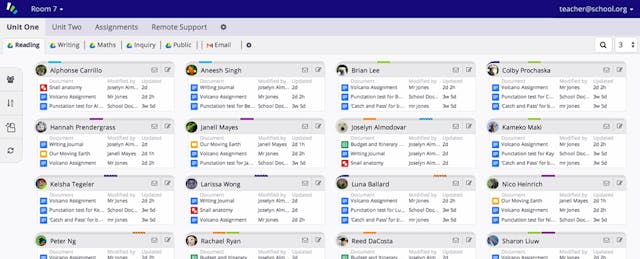Hapara's latest version of its Teacher Dashboard (above)
Palo Alto-based Hapara released three new tools this week at the annual ISTE conference, aimed at making it easier for teachers to use Google apps in school.
Use of Google Apps For Education is growing like wildfire: In 2010, Google said there were 10 million users; that number has since tripled. In May, Google said it was developing a tool it calls Classroom, that aims to help teachers organize, assign and collect work.
That’s where Hapara, which has it roots in New Zealand, started a few years ago. Over the past three years, Hapara has won fans in 35 countries and 20% of US school districts as it has given teachers a way to better manage Google docs. Now Hapara, too, is now upping its game with improvements and added features that it believes will convince teachers that their lives will be easier using Hapara’s dashboard and tools, rather than going with pure Google.
In an interview with EdSurge in late May, Hapara CEO and founder, Jan Zawadzki, said that Hapara continues to be a close collaborator with Google—and, he says, is finding ways to fine tune its product to meet the needs of teachers. Hapara’s most recent release of products and features address the specific request that the company has gotten. These tools include:
- Construct, for managing assignments and project-based learning that will become a part of the Teacher Dashboard;
- Insight, an analytics tool for using Google Apps for Education;
- A Teacher Dashboard, a dashboard that individual subscribers can use to make it easy to collaborate with any users with Google accounts—including parents.
Construct, which will be included as part of the Teacher Dashboard in the coming school year, will enable teachers to work with students to plan, design and assess assignments and projects. “It lets teachers sequence learning materials,” Zawadzki says, something that enables them to plan, engage and assess students, creating a transitional path that turns learning to students.
The Teacher Dashboard, which is in beta testing, will mean that individual teachers can use Hapara’s tools to manage Google Apps, whether or not their organization has a Hapara account. Using the Teacher Dashboard will involve paying a license to Hapara but the company has not yet disclosed what that will be.
And Insights, Hapara’s analytics platform, aims to be like a car’s “fuel efficiency” meter—but one that monitors students’ behavior across social networks to give teachers more feedback about how students are responding. “You’ll be able to see here are the students that are responding to your attention—and here are the ones who are not,” he says.


